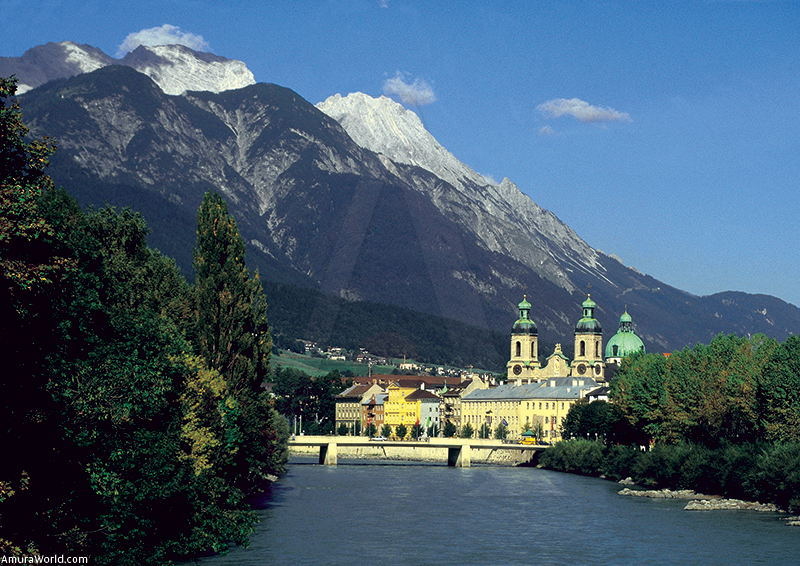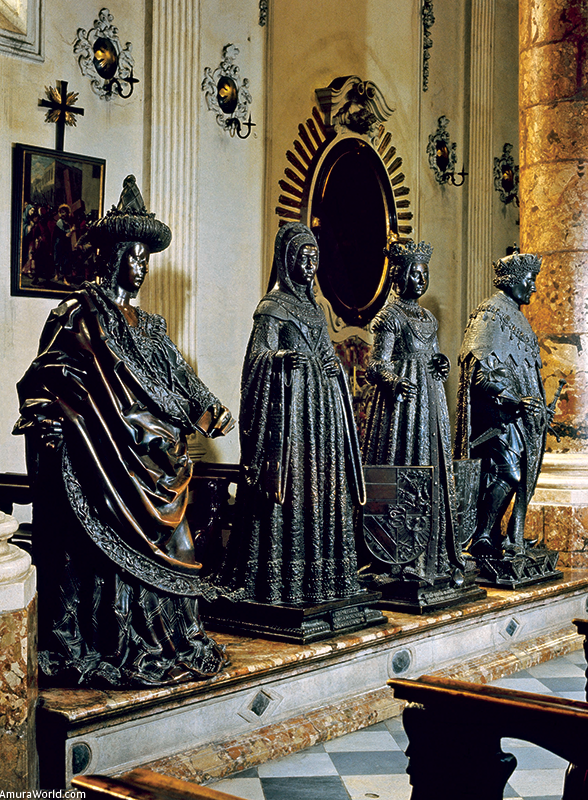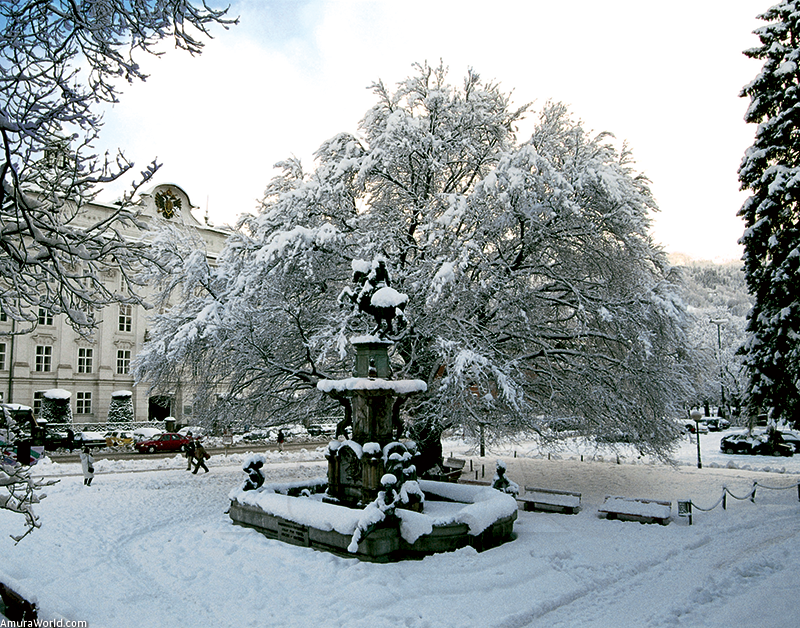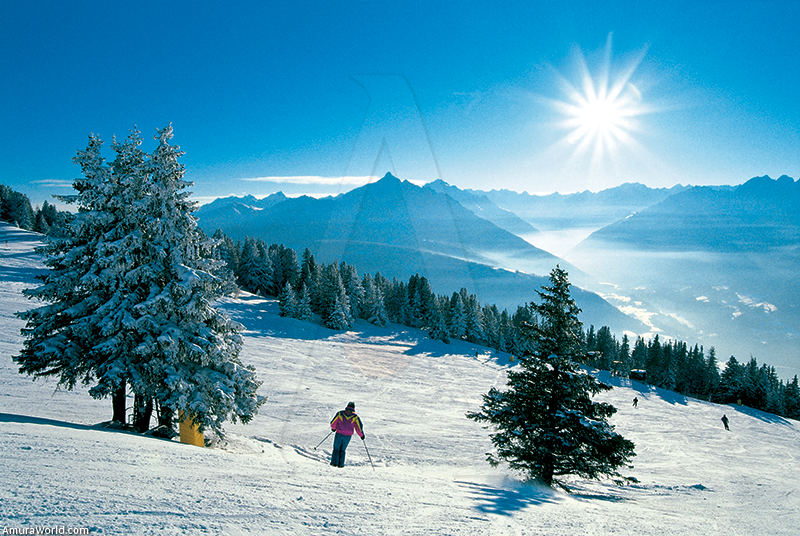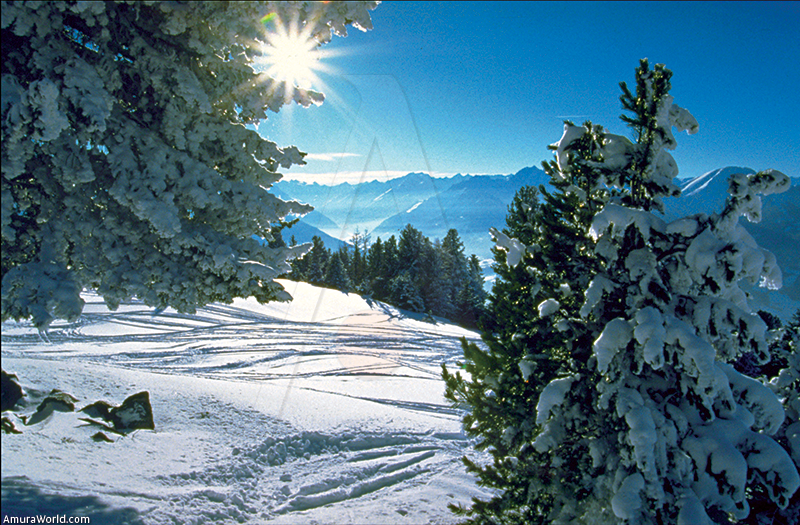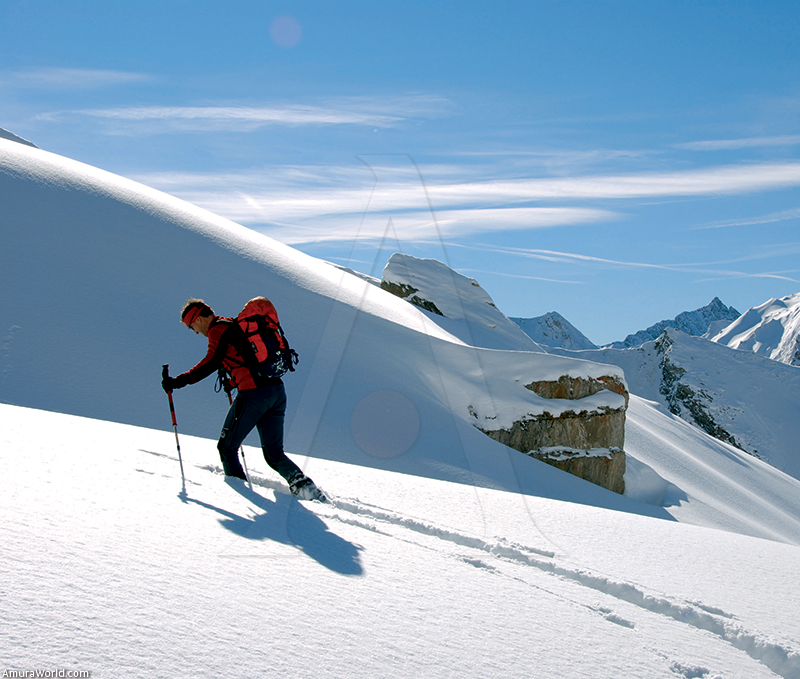Heart of the Alps
At the foot of one of the most important mountain chains of Europe is Innsbruck, capital city of the Austrian state of Tyrol, and is a unique destination for those who love active vacations. Weather it is in summer or in winter, the mountains of Innsbruck is ideal for excursions in green prairies or to get lost skiing in the snow.
It is not casual that this dramatic chain of moun- tains has served as an inspiration to so many philosophers, thinkers and poets. Among them the Swiss Albrecht von Halle, whose poem “The Alps", written in 1729, passed to history as one of the first hymns to the mountains that had fascinate an embellished everyone the same. The feeling that these mountains have instigated throughout the history has changed. In the ancient German mythol- ogy, Alp was an aerial spirit that dwelled in the top of the scraggiest mountains, going down once in a while to disturb the tranquility of the habitants of the nearby villages.
The dramatic views from these imposing heights are also which inspired the concept of the “sublime” for the romantic poets. The sublime, in this sense, evocates an aesthetic emotion that so intense may provoke the horror in form of an ungraspable torrent of emotions. Many poets, artists and philosophers have tried to describe the emo- tions that overcome to everyone that contemplates the world from these magnificent heights. Nevertheless, it is enough to climb one of them to understand, suddenly and with no need of explana- tions, to which they refer to.
Located in the valley of the Inn River, in the middle of high mountains, the Nordkette (Hafelekar, 2,334 meters above the sea level) to the north, Patscherkofel (2, 246 masl) and Saile (2,403 masl) to the south, Innsbruck has been the venue of the Winter Olympic Games in two occasions and counts with the perfect infrastructure for all the greatest transporta- tion and communications link between the north and the south and the simplest way to cross the Alps. The city generated incomes since it became a cross- ing site, which produced a development for the pros- perity of the same one. From it’s founding as a thriving city and strategically located, the history of Innsbruck was linked to great celebrities. The first figure connected to the city was that of the duke Frederic IV. of the family of the Habsburg, who in 1420 takes residency in this city and orders to build some of its most acknowledged constructions. One of them is nowadays one of the most representative monuments of Innsbruck, the Goldenness Dachl or “shed of gold", built between 1497 and 1500.
The emperor Maximilian I of Habsburg (1459- 1519), son of the emperor Frederic III and Leonor of Portugal, ordered to construct several monuments n Innsbruck, place to which they went frequently to go hunting, to go fishing and explore the mountains. The chapel located in he cave of the Martiswand rock recalls his passion for the hunt The legend tells that the emperor got lost by the Martiswand rock during a hunting party. Nowadays is possible to visit one of the mausoleums of Maximilian I inside the main church in the center of Innsbruck (Hofkirche). Already in the XVEQF1 century the empress Maria Therese I of Austria favored Innsbruck as one of the most beautiful places in which to appreciate the nature in al its splendor.
As well as being a place of a unique natural beauty. Innsbruck is also an important cultural center of Europe. The University of Innsbruck was founded in 1669 and today is one of the most important universities of Austria. A great part of the population of the city is undergraduates, which helps to keep it vibrant and active during all year long.
City tour
A visit to Innsbruck must begin climbing up the 148 stairs of the city tower. From there you can enjoy a panoramic view of the city: the historical center to its feet, where the rococo style facade of the Heblinghaus house stands out the Shed of gold and the Imperial Palace. A city marked for always by the emperor Maximilian I and the Habsburg family. The view continues toward the imposing North Mountain Chain (Nordkette) and. in the horizon, the snowed peaks of the Tyrolese Alps. Afterwards you may go to the street Maria-Theresien-Strasse, the most important of Innsbruck, to enjoy a hot bever- age in the city’s downtown.
This is a vast pedestrian zone between impres- sive old houses and modem commercial galleries. Here you find the Annasaule Column and the Arc of the Triumph (Triumphforte). commemorative monument of the events that took place in 1765. In that year the son of Maria Therese, Leopold II.
was married to the Spanish princess Maria Ludovico. After the wedding celebrations the hus- band of Maria Therese died of a sudden death, the emperor Francis I Esteban of Lothringen. The arc of the triumph recalls both events. In one side happy scenes are showed, and in the other, sad motives. It is also worth to visit the typical basilica of Wilten, the most beautiful church rococo style of Tyrol. This dates from the year 1755 and is an important pilgrimage place. Later on. you can go to the Ambras Castle, today the History of the Art Museum of Innsbruck. A famous renaissance cas- tle for its collection of portraits of the legendary Habsburg family and original pieces of that time.
Getting lost in the white vertigo of the snow
The facilities for practicing al the Winter sports in Innsbruck and its surroundings are almost inex- haustible. The Olympia Ski World Innsbruck reunites eight skiing regions: Nordpark-Seegrube. Patscherkofel, Axamer Lizum, Muttereralm. Glungezer, Schlick 2000, Stubaier Gletscher. Kiihtai and Rangger Kopfl. The Olympia Ski World Innsbruck is one of the most important skiing cen- ters of the Alps with 75 lifts and 270 km of tracks with snow insured.
Getting lost in the white vertigo of the snow
The facilities for practicing al the Winter sports in Innsbruck and its surroundings are almost inex- haustible. The Olympia Ski World Innsbruck reunites eight skiing regions: Nordpark-Seegrube. Patscherkofel, Axamer Lizum, Muttereralm. Glungezer, Schlick 2000, Stubaier Gletscher. Kiihtai and Rangger Kopfl. The Olympia Ski World Innsbruck is one of the most important skiing cen- ters of the Alps with 75 lifts and 270 km of tracks with snow insured.
Nordpark-Seegrube-Hafelekar
The most important sports enclosure of Innsbruck counts with a funicular up to the Hafelekar at 2,343 m of altitude. This is an important ski and snowboard center with spectacular panoramic views and excursions throughout the year.
Patscherkofel-Zirbenweg
The Olympic Mountain of Innsbruck, of 2,250 m of altitude, where the masculine slalom races were celebrated during the Winter Olympic Games of 1964 and 1976. This is the alpine garden with the largest altitude in the Alps and counts with an Olympic rink for bobsleigh and sledge.
Axamer Lizum
A popular region as much as for ski as for cross coun-try skiing, located between 1.600 and 2.300 m of alti- tude. it is also known as the dorado of the snowboard.
Muttereralm
Skiing station recently renovated. It has laid out soft tracks for beginners and families. Ideal for practice of the sled. The access can be realized through a panoramic and nostalgic tramcar that goes out from the downtown of Innsbruck.
Glungezer-Zirbenweg
This is a perfect region for the winter and summer family tourism. Located to the west of Innsbruck, offers a vast roads network signposted for the practice of the cross-country skiing.
Stubaier Gletscher
The glacier of Stubai, or the “kingdom of the end- less snow”, is the most important attraction of the region of Tyrol in which winter sports is con- cerned. Throughout the year, this place offers excellent snow conditions for the ski practice. From 1,750 to 3.200 m of altitude. Stubai has the best skiing tracks of all Austria and counts with modem facilities and of easy access.
Valley of Kiihtai Sellraintal
Impressive peaks, extensive valleys and pictur- esque lakes located between 900 and 1,690 m of altitude are the major attractions of this romantic natural paradise. At the end of the valley, at 2,020 m of height, the ski station at the most altitude in all Austria is located.
Rangger KOpfl
This mountain of 1,939 m of altitude is found next to the town of Oberperfuss. Counts with routes oh high mountain and here may be realized the famous route of the Rose of the Alps. The family skiing and sled tourism is especially frequent in this location.
Neighbor towns
The region of Tyrol also counts with 25 traditional and picturesque villages very near to Innsbruck and easily accessed to along the Inn River. These are some of the most important.
Kematen
The name of this city comes from the Latin word “caminata” (long walk), which evokes the beauty of its surroundings. This town combines the tradi- tion with the assorted sports activities typical of this zone. Located at the entrance of the Sellrain valley. Kematen is the exit point for several excursions by the mountains.
Rum
Of the neighbor towns of this area. Rum is the clos- est to Innsbruck. From here you arrive to the alpine park of Karwendel. in which you can practice a great variety of sports in winter as well as in summer. The village also counts with buildings that date from the second half of the Xlllth century.
Vttls
The spectacular lake of Vols is the greatest attrac- tion of this town. Here is also found Museum of Thurnfels, which houses an important collection of devices that date from the bronze and that were discovered in this location in 1881/82. The view of the mountains from this location is something that you should not miss.
Zirl
A historic place, at the foot of the Zirl Mount and of the impressive rock of Martiswand. where the emperor Maximilian got lost during a hunting party. This place is famous for its wines and for being favorable for the beautiful “alpine orchids”, and can be appreciated in the road. Here are also found the ruins of the castle of Fragenstein which date from the XII**1 century. A1 this combined with the different sport activities such the rock climbing. excursions, biking and ski.
Climate
In winter, the Tyrol is perfect for the practice of the ski. Numerous stations offer all the services and proposals, as well as a great ambience of après-ski. From April to September the green covers the val- leys and then the cross-country skiing and the alpinism are the star sports.
The region of Innsbruck and its neighbor towns have a relatively cold weather throughout the year. Because it is a mountainous region, the weather may change drastically in only one day. In the summer it is possible to have placidly warm days followed of cold days and with freezing wind. During the winter the snow is guarantied and the el weather is ideal for the practice of the winter sports.
In addition of the multiple opportunities of skiing during the winter. Christmas is an impor- tant date in the calendar of Innsbruck and its sur- roundings. In these dates the Christmas market is installed in Innsbruck and all the province is filled with decorations and lights.
Currency
The official currency of Austria is the euro. The type of exchange is of 16.32 Mexican pesos for euro. It is possible to pay with a credit card in the most of establishments and hotels, and it is also very easy to withdraw cash from ATM machines located in the entire city. To tip is used in Austria. In restaurants the tip may vary from a 10 to a 15 % of the total of the check.
How to Get There
The best way to arrive to Innsbruck is flying to Frankfurt from Mexico by Lufthansa. The flight to Frankfurt from Mexico City has daily departures directly to Frankfurt and from Frankfurt there are two daily flights to the airport of Innsbruck through Austrian Airlines. Another option is flying to Frankfurt and continues to Munich. In the German city you can rent a car to continue to Innsbruck, or otherwise travel in autobus or with the Transalpine Train, which realizes a beautiful trip among valleys and canyons fitted between the mountains.
Gastronomy
The food of the region of the south of Tyrol prides itself of a very old tradition. The wine and the cheeses abound in this region and take part of the daily life. The traditions of the region are intimate- ly bounded to these products. One of these tradi- tions is expressed in the word “Törggelen”, coming from the Latin "torquere", which means press and spin. This refers to the technique of pressing the vintage, which was the traditional way of making wine years ago. It was a custom of the local people to walk from vineyard to vineyard to taste the wine of the new vintage, a practice that is still alive nowadays.
The weather of the mountain reflects itself in the consistency of its main dishes. Some examples are: the Tyroler Gröstl (potatoes with fried jam), the Kärnten Kasnudl (pasta filled with cheese), the Tafelspitz (boiled beef meat), the sausages of all kind and other more familiar dishes such as the Wiener schnitzel (escalope «to the Viennese») and desserts such as the Apfelstrudel (apple cake). In Innsbruck, in the little streets of the historical center, there is plentiful of cozy restaurants and the family boarding houses.
Shopping
In the Tyrol the wood crafts stand out. Other typi- cal products are the Tyrolese’s dresses for ladies or Dirndl, which nowadays are designed in modern versions and very costly.
In Innsbruck you may visit the headquarters of the Swarovski’s crystal shops, where are objects made with this material are exposed and sold. You may also visit its singular museum, where every- thing spins around the crystal world. The muse- um. Worlds of Swarovski Crystal, is located 20 km to the east of Innsbruck, in Wattens. This museum is the most visited of Austria after the castle of Schónbrunn of Vienna. The crystal exhibited in its halls fascinates to every visitor with its multicol- ored highlights. The pieces are made by several international artists. The museum also counts with a gift shop very well assorted.
Documentation
For stays that does no exceed the 90 days is neces- sary the valid passport and that it has validity for at least three months after the date of your trip. It is also required to take the ticket out.
Info
Margarita Liceag
Servicios Especiales de Leisure
BCD Travel
Tel: (55) 9138 3023
conmutador: (55) 9138 3000
margarita.liceaga@bcdtravel.
Text: Kundalini Muñoz ± Photo: Cortesía de compás int • compass int © Innsbruck Tourismuss




